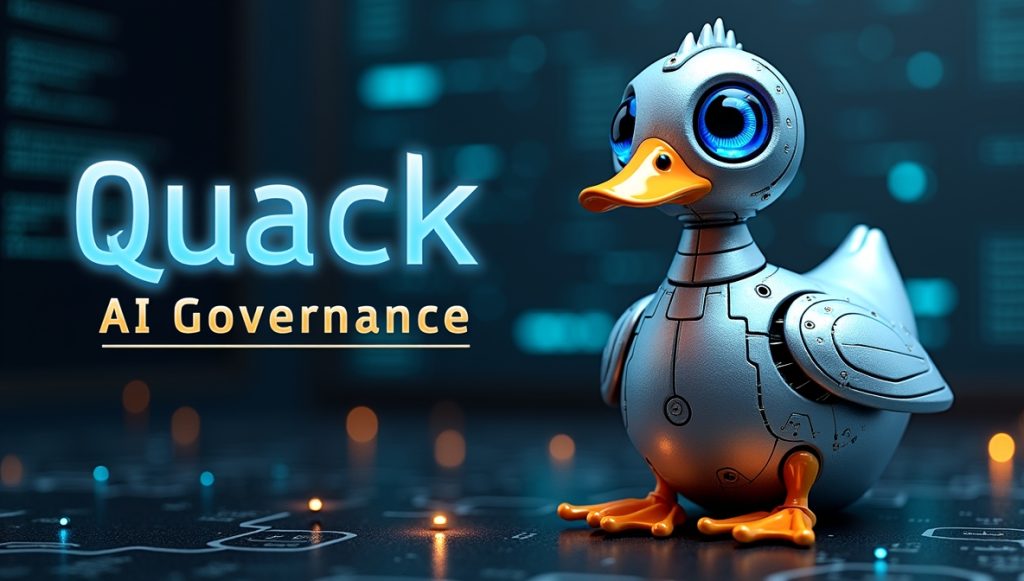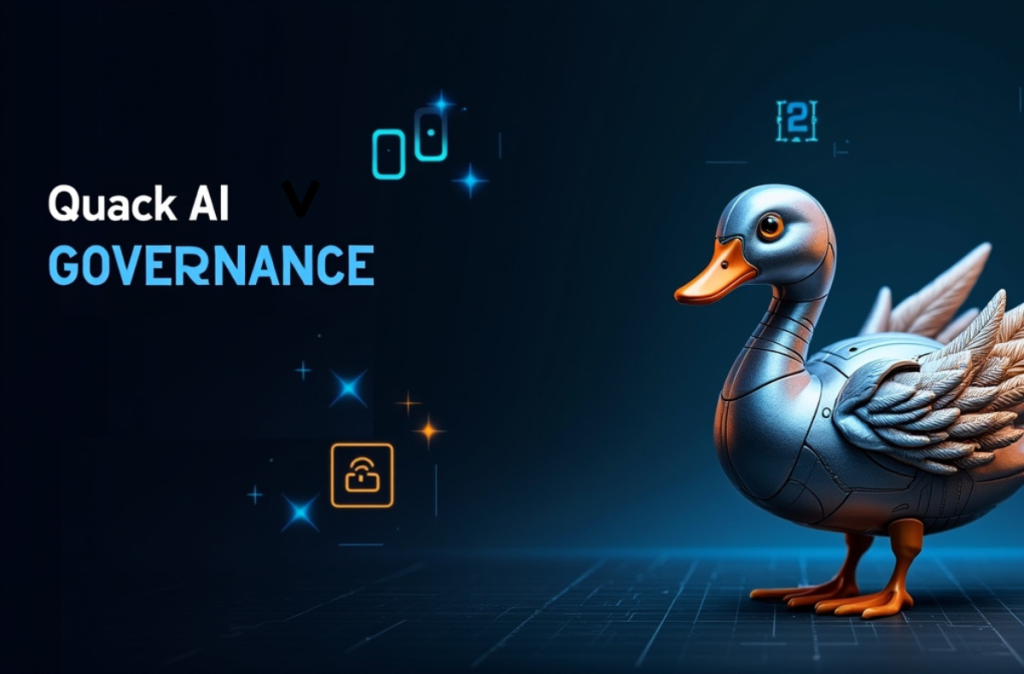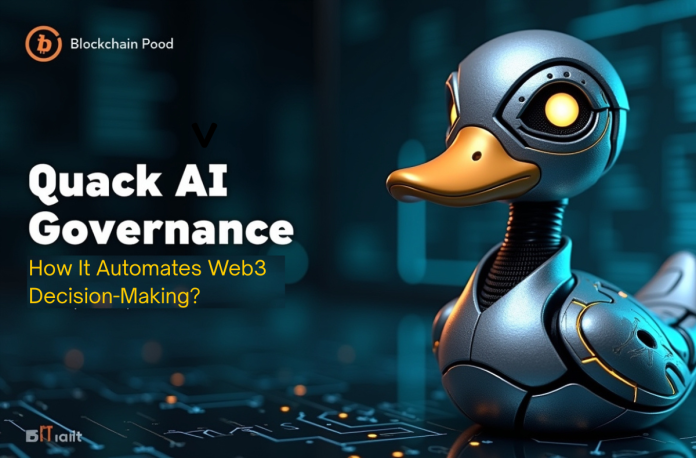Do you feel like your Decentralized Autonomous Organization (DAO) is moving at a snail’s pace? It’s a common struggle in Web3. Decentralized governance, handled by messy manual voting, suffers from chronic gridlock. Critical decisions get stuck for weeks, but the market moves in minutes. This problem is systemic. In fact, the core paradox of decentralized governance is acute: less than 10% of token holders typically participate in voting, paralyzing many protocols. This is the systematic failure that Quack AI Governance was specifically designed to solve.
The good news is that Web3 is now adopting intelligent automation. Introducing Quack AI governance, the world’s first AI-driven blockchain protocol to automate Web3 decision-making. This system uses autonomous AI agents to automate decision-making, transforming governance from a bottleneck into a real-time competitive asset. You need to understand how this technology ensures your project scales faster. Let’s explore how Quack AI governance is changing the future of organizational autonomy.
Table of Contents
What is Quack AI Governance?
If you want to know what AI governance is in the context of Web3, consider it this way: Quack AI is the smart infrastructure layer that transforms organizational decision-making out of messy human voting pools to highly effective, data-driven automation.
In a normal DAO, decisions rely on a decentralized governance model where every token holder must manually cast a vote. As DAOs grow, this process breaks down. Participation often drops below 10%. It is hard work to read every proposal and analyze all the risks involved. This is what we call voter fatigue.
Quack AI governance fixes this problem by adding autonomous AI agents directly into the operational framework of the DAO. These agents are trained to evaluate proposals, monitor sentiment, and carry out governance decisions instantly. This mechanism guarantees continuous participation. It transforms the organizational structure. The system effectively ensures that governance scales at the same speed as the protocol’s financial growth.
Why Are Traditional DAOs Slow and Unfair?
The speed issue is clear. People can debate for weeks, stall proposals, and fail to make necessary updates quickly enough to keep up with market shifts. The fairness problem, however, is often more insidious.
Traditional token-based voting systems often mean that large token holders, or “whales,” have too much power. As a result, they can easily force policies to their own advantage, sometimes ignoring the community’s best interests. People usually call this concentration of voting power a plutocracy risk, which goes against the core promise of a truly democratic and Decentralized Autonomous Organization (DAO).
In contrast, Quack AI governance directly solves these failures. Specifically, the platform reduces whale dominance and guarantees better outcomes by implementing preference-based delegation. Moreover, the AI agents operate only on predefined rules and transparent data analysis. By doing so, this filter removes emotional bias and corruption that often ruin human-driven votes. Ultimately, the result is a much more stable and trustworthy DAO.
How Does Quack AI Automate Decision-Making in Web3?
The technical breakthrough of Quack AI governance is that it doesn’t just record a vote; it brings sophisticated intelligence to the entire on-chain voting process and execution. It is a system that uses agentic AI, meaning the agents pursue complex goals with limited human supervision. This is not simple automation. This is intelligent, adaptive, and scalable Web3 decision-making automation.

The AI Delegation Model
The cornerstone of the Quack AI governance solution is the AI delegation model. If you are a token holder, you can set your strategic preferences for how you want your tokens voted. Think of it like hiring a specialized investment manager, but this manager is an AI agent running on the blockchain.
You delegate your governance power to an AI agent that is perfectly aligned with your preset preferences. These specialized agents then examine and transparently implement votes across several chains on your behalf. Governance participation remains effective even during the time when you are offline.
The system also enhances equity through Governance Certificates. Through interaction with the Quack AI platform, the user earns points and converts them into governance power. It implies that millions of individuals can gain effective participation rights without the major token holdings or warranting active manual participation in each and every decision.
Intelligent Proposal Analysis and Automated Execution
The Proposal Engine, which is an essential part of the Quack AI governance engine, works before even a single vote is cast. This AI component analyzes draft proposals for risks and viability. It automatically reads and understands detailed documents, community discussions, and live on-chain data. This smart AI-enabled decision support turns all that complex information into simple, useful insights for both the human community and the AI agents.
Once a decision is made, the automated governance mechanism seamlessly manages everything else. At this stage, Quack AI governance really proves its value. Instead of manually approving each step, people can rely on the system to handle it automatically. In practice, proposals are reviewed by AI agents, and decisions are made independently. As a result, this process covers activities like releasing funds, distributing rewards, and handling ownership shares through smart contracts.
The system is compatible with the most popular blockchains such as Ethereum, Solana, and Arbitrum, which makes it very flexible and easy to use. This multi-chain governance infrastructure allows the system to manage complex DAO operations across segregated ecosystems from a single interface. Everything is managed through auditable and efficient Quack AI on-chain processes.
| Feature | Traditional DAO Governance | Quack AI Governance |
|---|---|---|
| Decision Speed | Slow (Weeks-long voting, gridlock) | Instant (Real-time analysis and automated execution) |
| Voter Apathy | High (Often <10% participation) | Low (Delegated AI agents ensure continuous participation) |
| Bias/Fairness Risk | High (Whale dominance, token-weighted) | Low (Preference-based delegation, data-driven decisions) |
| Mechanism | Manual on-chain voting process | Automated governance mechanism with AI agents |
| Execution | Manual, requiring human confirmation/multisig | Automated smart contract execution across multiple chains |
Where Will You See Quack AI Governance Working?
The application of Quack AI governance is incredibly extensive. Due to its modular design, developers can update protocols to use discrete functionality, such as risk checks or proposal scoring, without fully migrating them. This plug-and-play strategy makes the AI governance framework ideal for numerous high-value sectors.
1. DeFi Protocol Optimization
For Decentralized Finance (DeFi) platforms, speed is everything. Market changes happen in seconds, but human governance takes days. Quack AI governance provides essential automation capabilities.
- AI-Optimized Treasury Management: The system automatically allocates funds for growth and sustainability. AI agents assess funding requests based on historical performance and impact analysis to determine the best plan.
- Real-Time Risk Management: Automated risk assessment and proposal evaluations allow DeFi projects to respond instantly to market volatility. This facilitates advanced operations like liquidity routing and portfolio management.
2. Real-World Asset (RWA) Integration
The RWA market, which involves tokenized assets like real estate and commodities, therefore requires intense compliance and credibility. In this context, traditional finance institutions need verifiable accountability.
To address this, Quack AI governance builds the necessary infrastructure to meet this need. Specifically, it directly places legal agreements and audit processes on Quack AI on-chain. As a result, the system fulfills the core requirements of traditional corporate governance, as it provides verifiable accountability and traceability. Ultimately, this automated compliance makes RWA integration both trustworthy and scalable.
3. Cross-Chain Coordination
Since Web3 is distributed across numerous blockchains (Ethereum, Solana, TON), it becomes a nightmare to coordinate decisions. The multi-chain governance layer of Quack AI governance enables the seamless coordination of actions by DAOs.
As an example, a complex environmental DAO may automatically vote in climate governance on various blockchains via AI-mediated voting, making sure that its mission objectives are implemented constantly. This is essential when it comes to cross-protocol and large-scale work.

Trust and Transparency
The primary risk in any AI governance framework is the “black box” problem. How can you trust an agent if you cannot see why it made a decision?
Quack AI governance uses the immutable nature of the blockchain to solve this trust issue. It moves beyond simple transparency to verifiable explainability.
- On-chain Decision Logs: Every recommendation generated by an agent is verifiable on-chain. In other words, you can check the entire chain of reasoning behind each decision. As a result, this creates a tamper-proof audit trail for real-time monitoring.
- Cryptographic Proofs: The protocol layers in cryptographic proofs and anomaly detectors. These double-checking agents review everything before execution. This system ensures that decisions are robust and aligned with ethical standards, addressing the urgent need for a strong AI governance framework.
The goal is to provide institutional trust. When regulators increasingly demand greater auditability, this verifiable chain of reasoning serves as the ultimate defense against claims of bias or opacity.
What About the Quack AI Governance App and Price?
If you are looking to get involved, you will probably use the Quack AI platform, most likely through its easy-to-use Quack AI governance app interface. The platform’s success comes from its user-friendly interface that lowers the barriers for less technical members, encouraging higher turnout.
Regarding the Quack AI governance price, the system uses its native token, Q, for incentive alignment. Token holders stake Q to back preferred agents and participate in module upgrades. Model creators make money when their specialized AI models are used. Although the current Quack AI governance price changes like any token, the fundamental economic model provides accountability. Decisions are verified by staking tokens by the validators, establishing a financial deterrent against false verification. This brilliant system secures an economically friendly network to act honestly and responsibly.
Conclusion
Quack AI governance represents a fundamental shift in the functioning of decentralized systems. It brings Web3 out of human governance failures into scalable, automated engineering success. By utilizing advanced AI agents for Web3 decision-making automation, the protocol effectively eliminates long-term inefficiencies such as voter apathy and slow execution.
The system’s technical depth, multi-chain compatibility, and focus on verifiable explainability are not just optimizations; they are prerequisites for large-scale adoption in finance and Real-World Assets. I genuinely believe this is the AI governance substrate the Web3 industry needs to move forward. By adopting the Quack AI governance model, protocols can finally scale alongside their growth.
What will your DAO build when governance is no longer a bottleneck? In 2025 and beyond, Quack AI governance envisions a system where you delegate power to an agent, check a dashboard, and trust it to execute decisions instantly, fairly, and intelligently.
FAQs
Quack AI governance is an AI-based, AI-driven blockchain protocol that automates proposal analysis, streamlines the on-chain voting process, and facilitates the execution of smart contracts for DAOs and Web3 projects. Moreover, it takes real-time, data-driven decisions using specialized AI agents.
It solves voter apathy with an AI Delegation Model. Users entrust their voting rights to AI agents based on their preferences, allowing them to participate without personally voting on every suggestion.
Yes, the Quack AI platform keeps things transparent by using an AI governance framework that records decisions on-chain while backing them with cryptographic proofs. As a result, any user can examine the chain of logic leading to each AI-generated decision, thereby making them absolutely auditable.
The major use cases are DeFi Protocol Optimization, where it handles treasury and risk in real-time, and RWA integration, where it offers verifiable compliance and accountability for tokenized assets. Moreover, all critical decisions are executed efficiently by Quack AI on-chain.
Governance Certificates are digital tokens that signify voting rights. They are earned by the users in terms of interaction points on the Quack AI platform. People use these certificates to democratize governance by separating voting rights from token wealth, allowing more participants to take part in the Decentralized Autonomous Organization (DAO).











